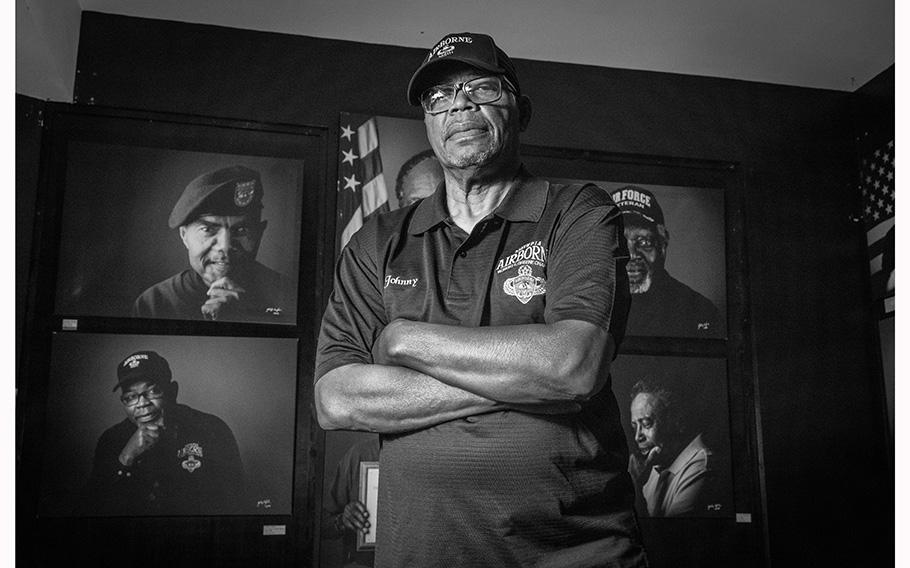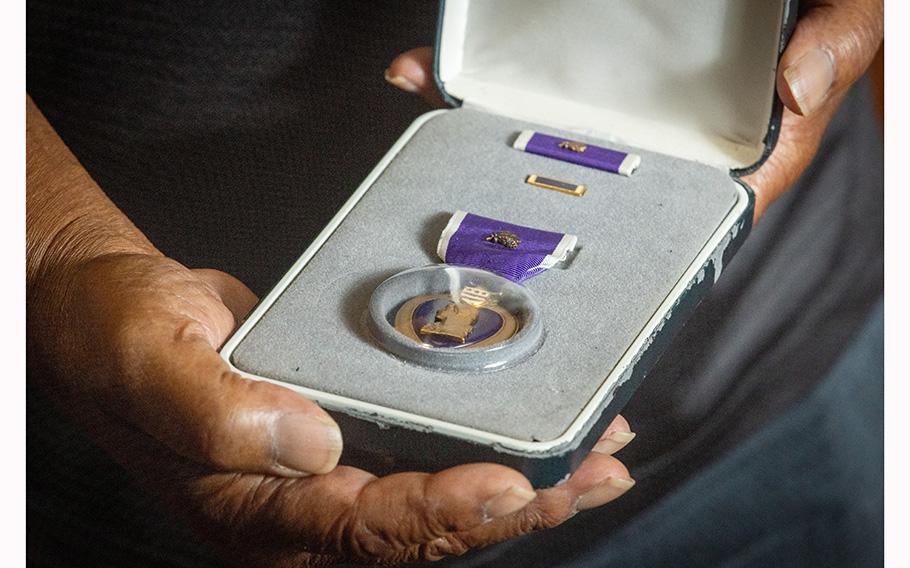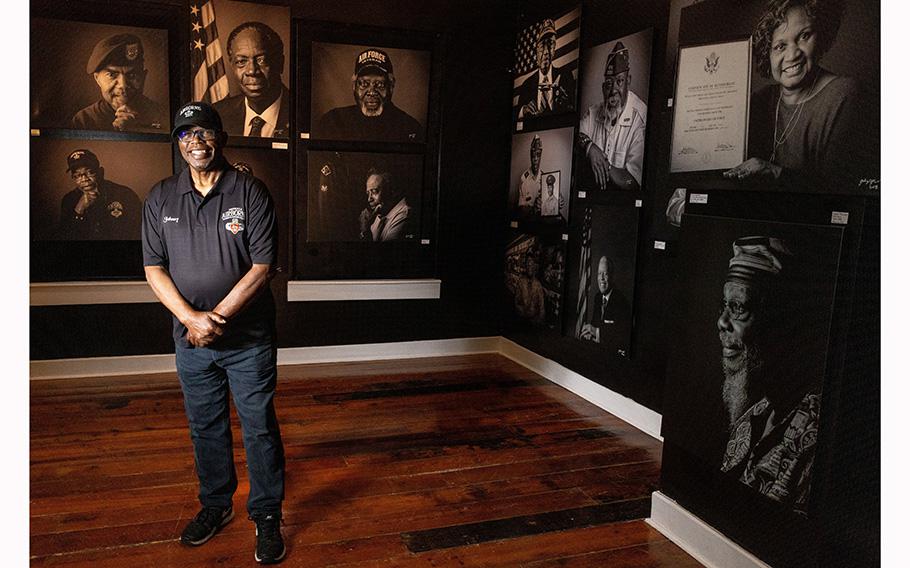
Vietnam Veteran Sgt. Johnny Miller stands in front of a series of portraits of Black Vietnam War veterans now on display at the Marietta History Center Tuesday, June 27, 2023. (Steve Schaefer/TNS)
(Tribune News Service) — Sgt. Johnny Miller fought his way up Hill 875 in Vietnam’s central highlands until a fellow paratrooper noticed Miller was bleeding. Incredulous, the Georgian checked himself, confirming he had indeed been hit in the chest with enemy gunfire.
As North Vietnamese troops attacked from behind and along their right flank, Miller and his men found themselves nearly surrounded amid the ferocious 1967 Battle of Dak To. A U.S. jet pilot swooped down and dropped two bombs, hoping to tip the balance in the Americans’ favor. But one exploded in the middle of the paratroopers, killing many and wounding even more.
The blast ripped open Miller’s left leg. Grievously wounded, he narrowly survived and was eventually evacuated from the battle, only to land squarely in the middle of another one. As Miller was hospitalized, the Rev. Martin Luther King Jr. was assassinated in Memphis.
“Black soldiers were fighting on two fronts,” said Miller, an Atlanta resident who received two Purple Hearts for his wounds. “When we came home, the war was not over for us.”
Miller, 79, is featured in a series of portraits of Black Vietnam War veterans on display at the Marietta History Center, just off Marietta Square, through Aug. 12. A discussion at the center about the portraits is scheduled for July 18 at 6 p.m.
The exhibit honors the roughly 300,000 African Americans who served in a war that disproportionately affected them. While Black people represented less than 15% of the U.S. population in 1965, they made up 31% of the ground combat battalions in Vietnam and suffered nearly a quarter of all the U.S. Army’s fatal casualties that year, according to the U.S. Library of Congress.
King’s criticism of the war still resonates with Miller today. The same year Miller was wounded on Hill 875, King condemned the war during a speech in New York’s Riverside Church, calling it “an enemy of the poor.” King added that young Black men were sent to “guarantee liberties in Southeast Asia which they had not found in southwest Georgia and East Harlem.”

Johnny Miller of Atlanta received two Purple Hearts for his wounds from the Battle for Hill 875 during the Vietnam War. (Steve Schaefer/TNS)
Johnny Crawford, a former Atlanta Journal-Constitution photojournalist who created the exhibit, has photographed more than 50 Black Vietnam War veterans so far. Intimately shot in black and white, the portraits have been displayed along Atlanta’s Beltline and in Jackson, Macon, Powder Springs and Riverdale and at Minnesota State University.
As he photographs the veterans, Crawford routinely hears about the racism they faced. Some resisted being photographed, Crawford said, because they were still haunted by their experiences in combat. Others talked about the criticism they endured from anti-war protesters.
“You didn’t want to go in the first place. Then you get over there and see something you have never seen before. Then you come back and people don’t care for you. And then you can’t get a job,” said Crawford, whose uncle served as a U.S. infantryman in the Vietnam War.
Some of Crawford’s subjects have died since he photographed them. One, a former U.S. Army corporal from Atlanta who served in Miller’s unit, took several buses and showed up a week early for his photo shoot because he knew he was dying and wanted to be remembered.
“I want to make sure people know who these people are,” Crawford said. “If I don’t do it, who will?”
Hill 875
The son of a sand company worker and a homemaker, Miller was born in Junction City, outside Columbus. He was drafted in 1965, the year he turned 21. Miller opted to join the 173rd Airborne Brigade, nicknamed the “Sky Soldiers.”
After Miller arrived in Vietnam his unit was ordered to capture a hill in South Vietnam, not far from the Cambodian and Laotian borders. Unbeknownst to the paratroopers, North Vietnamese soldiers had meticulously prepared on that hill, building trenches and bunkers amid the “triple canopy” jungle and connecting their fortifications with tunnels.
As Miller and his squad climbed the hill, he said, “that is when all hell broke loose.” The vegetation around them started falling, as if it were being cut down with invisible chainsaws. The North Vietnamese tossed grenades down the hill, fired rockets and mortars at the paratroopers and started flanking them.
A fellow soldier from Georgia glanced at Miller and told him, “Sergeant, you are bleeding.” At first, Miller didn’t notice because he was full of adrenaline. The pain set in when he spotted the gunshot wound in the right side of his chest. Their commander ordered them to pull back.
“We didn’t have time to even dig a hole or anything. We just had to pull back and try to set up a perimeter,” Miller said. “There was lead flying and everything.”
At times, the fighting was face-to-face and desperate. The paratroopers were fired upon from three directions. Some were bayoneted.
Pfc. Carlos Lozada valiantly covered the paratroopers’ rear with a machine gun, killing at least 20 North Vietnamese troops and buying his comrades precious time to withdraw up the hill. Meanwhile, his unit’s chaplain, Maj. Charles Watters, repeatedly exposed himself to enemy fire so he could minister to fallen comrades. Both Watters and Lozada were killed in the battle and posthumously awarded the Medal of Honor, the nation’s highest military award for valor.
Relentless enemy fire blocked U.S. helicopters from resupplying the paratroopers. Meanwhile, American planes set parts of the hill ablaze with napalm. Miller could feel the heat from those fires as U.S. artillery pounded the enemy’s bunkers above him.
At one point, a Marine Corps A-4 jet joined the fight and inadvertently dropped a 250-pound bomb on the paratroopers’ command post, where wounded troops had been assembled for evacuation. Military records say the explosion killed between 20 and more than 40 paratroopers, including Chaplain Watters, a company commander and other officers.
The explosion tore open Miller’s left leg and knocked out much of his hearing. Miller’s leg wound was so deep that he could stick his whole fist inside it.
“I thought the world was coming to an end,” he recalled.
In severe pain and bleeding profusely, Miller realized he had lost his rifle in the explosion, leaving him with a single grenade. He prayed for his life as he sought cover next to a fallen tree. Worried North Vietnamese troops would find him and try to cut his throat, he prepared to pull the pin on his grenade and blow himself up.
“God gave me another chance,” Miller said.
Jon Wambi Cook, who served as a radio operator with the 173rd during the battle, said the Marine jet’s bomb hit close enough that “it bounced me up off the ground.” He heard fellow paratroopers moaning and calling for help. In the glow of enemy flares floating down from the sky, he crawled toward the blast site and sought to help the wounded.
“I couldn’t believe what I was looking at,” said Cook, president of the 173rd Airborne Brigade Association. “There were body parts strewn everywhere.”

Johnny Miller is gratified by the patriotism he sees in the photo exhibit of Black Vietnam War veterans. “It shows that we care,” he said. “We care about our country. We have fought in all of the wars that America has ever had.” (Steve Schaefer/TNS)
Reinforcements eventually arrived and evacuated Miller and the other wounded soldiers. U.S. troops captured the hill on Thanksgiving Day before abandoning it days later.
Stephen Greene, who served as a helicopter pilot for the 173rd, was struck by the bravery of the paratroopers and the surreal scenes he witnessed when he landed atop Hill 875 after the battle was over. The terrain there was “devastated.” Dozens of his fellow soldiers had been killed or injured capturing it.
“It just didn’t seem like anything real to me,” he said of the hilltop, adding: “You felt, ‘God, it is over. We did it. We beat these guys.’ But then, years later, when I began to think more about this I thought, ‘At what cost?’”
‘What did I do all this for?’
The civil rights movement was still raging when Miller returned home. He was hospitalized for about a year and a half, first in Vietnam, then in the Philippines, then in Japan and then in the United States. Surgeons removed his left kneecap. He still carries shrapnel in that leg and walks with a limp.
“When you got home, you still did not have your rights,” he said. “So you said, ‘What did I do all this for?’”
For a long time, Miller avoided wearing his uniform in public because anti-war protesters were blasting American veterans returning from Vietnam. He was honorably discharged from the military in 1969.
Miller was the first veteran Crawford photographed for his exhibit. Crawford heard Miller’s harrowing story during a breakfast for veterans at the Atlanta house of worship they both attend, Cascade United Methodist Church.
Crawford also learned that Miller filed a civil rights lawsuit in 1972 against the Atlanta automotive plant where he worked before the war, alleging the company wouldn’t give him his old job back because of his combat injuries and that it discriminated against Black people in how it hired and promoted workers. Miller said the company settled out of court and that he changed careers, ultimately becoming a printmaker and an entrepreneur.
Though he is nearly 80, Miller still operates lawn care and property management businesses. Remaining busy, he said, helps him stay mentally healthy.
Miller occasionally experiences flashbacks about Hill 875 and has been diagnosed with post-traumatic stress disorder. At first, he hesitated about seeing a therapist for his PTSD symptoms because of the stigma surrounding the condition. He decided to seek help when he learned a late cousin experienced intense nightmares from serving in Vietnam.
“He would wake up fighting. I didn’t want to go through that,” Miller said.
Miller recently visited Crawford’s exhibit at the Marietta History Center, marveling at the pictures. For his own portrait, Miller wore a hat carrying the emblem of the 555th Parachute Infantry Battalion. The Army’s first all-Black paratrooper unit, the 555th was trained for combat but deployed to put out any fires ignited by bomb-laden balloons Japan launched at North America during World War II. Miller leads the Atlanta chapter of an association honoring the groundbreaking unit, nicknamed the Triple Nickels.
Glancing around at the familiar faces of fellow Black Vietnam War veterans in the exhibit, Miller was gratified by the patriotism he saw.
“It shows that we care,” he said. “We care about our country. We have fought in all of the wars that America has ever had.”
©2023 The Atlanta Journal-Constitution.
Visit at ajc.com.
Distributed by Tribune Content Agency, LLC.